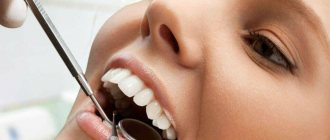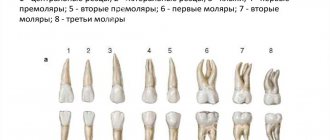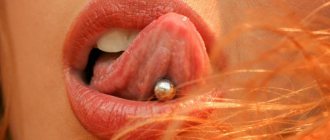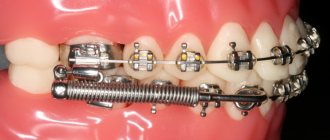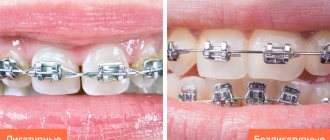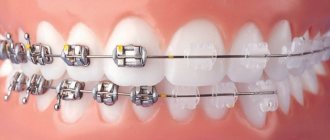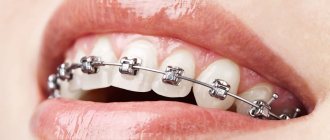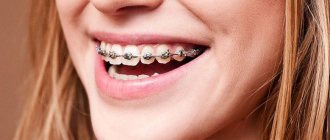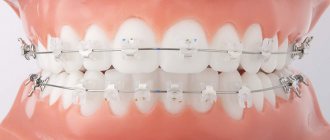Today, the most comfortable and effective means used to correct a malocclusion are braces. This is a complex device that allows tooth movements in the required direction, without unnecessarily changing the inclination of the root. It is the only orthodontic system that allows you to move a tooth in any direction, including rotating it along its axis.
How do braces work? This is one of the most common questions that patients are interested in, no less than “does it hurt to install braces”, “how much do braces cost?”
Not everyone believes that such small devices can move a tooth over long distances. Let's look into this issue.
How does the braces system work?
The braces themselves are not able to correct the position of the tooth. Bite correction is carried out by an arch that connects the teeth with braces and moves them to the required position. In order for the bracket system to successfully complete its work, it is necessary to periodically replace the arch with a more elastic one.
The bracket is glued to the tooth in the center of the crown. Each tooth has its own bracket. For example, if you do not glue the bracket that is intended for the canine onto the incisor, then the incisor will never become beautiful and even. This is because each brace has specific angles, which are different for each tooth. Now you can understand why the cost of bracket systems is so high, because they are not ordinary metal brackets, but metal brackets manufactured with maximum precision. If they are placed upside down or reversed, the braces will not work as well as they should. But in some cases, orthodontists specifically change the position of braces or their places. These are the subtleties of this or that non-standard clinical case, as well as the features of the creative work of an orthodontist.
How the archwire is attached to braces
Design
The bracket system always consists of two main parts:
- special arc;
- brackets or brackets (locks) that are fixed to the surface of the dental unit.
The clasps are attached to the inner or outer surface of the bony organ of the oral cavity using a special adhesive.
Next, a special metal arch is inserted into the groove of the brackets, which is held in it with the help of rods (elastic bands, ligatures). Their fixation is performed on the wings of the bracket.
If the system is ligature-free, the device operates without rubber bands, and the effectiveness of the correction is ensured by a special design.
Modern braces have greatly improved. They not only have a miniature size, but are also made from various materials:
- metal;
- plastic;
- ceramics;
- sapphire.
Metal braces have become very popular. The following metal alloys are used for the manufacture of brackets and special arches:
- steel;
- titanium;
- Nickel
Ceramic and plastic systems have a perfect aesthetic appearance, are durable and safe, however, they are expensive, which makes them less affordable for most patients.
In addition to the main elements, the bracket system can be equipped with orthodontic rings with a soldered locking part, which are attached to the last chewing units, and sometimes to the wisdom tooth.
The presence of these elements is appropriate when it is not possible to secure the bracket (large filled area at the attachment site, artificial tooth).
Before installing the rings, the orthodontist fixes the separators, which will temporarily ensure the separation of the bone organs for several days.
Another important additional element of the braces system is the elastic chain. Its action is to contract, which brings the braces closer along the arc, which means it reduces the distance between the teeth.
In addition to all the listed elements, during orthodontic treatment with braces, specialists use the following parts:
- metal springs;
- buttons;
- metal ligatures;
- metal bands for a group of dental units;
- special tubes for the arc made of silicone;
- turbobytes;
- bite fillings.
The principle of operation of the braces system. Memo for the patient.
Each tooth has a visible part - the crown, and also an invisible part - the root, held by ligaments inside the bone tissue. Malocclusion can occur as a result of incorrect jaw position, as well as a discrepancy between the volume of dental tissue and the size of the teeth. Braces can help correct the bite of permanent teeth. This is a complex consisting of braces (separate locks for each tooth) and an arch, which is inserted into each bracket, connecting all the teeth into a single chain. It affects the position of teeth by changing the tension of dental ligaments and bone tissue. It is with the help of arches that the mechanism for moving teeth is started, as well as control over their position in 3 planes, regardless of what system you have - lingual braces, including lingual braces stb, invisible braces "Incognito".
Installation of veneers
Veneers are porcelain or composite plates that replace the outer thin layer of a tooth.
Effectively correct dental discoloration, cover cracks or stains due to enamel hypoplasia. Veneers are an aesthetic solution and do not replace orthodontic treatment. Unlike veneers, braces move teeth. Treatment with braces ensures the formation of an aesthetically correct smile, restoration of the physiological bite and function of the dental system. The material is for informational purposes only and is presented for informational purposes. It does not replace consultation with an orthodontist and is not a guide to correcting dental anomalies.
Why might I experience discomfort or pain after getting braces?
The arches that are used on the bracket system at the beginning of orthodontic treatment have shape memory. Therefore, no matter what bend the arch placed in the groove from the braces makes, it tries to return back to its original position, thereby affecting the position of the teeth and straightening them. Unpleasant sensations that occur immediately after installing braces can most often be associated with the fact that constant tension develops inside the bone due to the work of the arch. Adaptation of the ligaments of teeth in the upper jaw occurs within 3-5 days in adolescents and after 7-10 days in adult patients. The bone tissue on the lower dentition is denser, which is why addiction can last up to 10-12 days in adult patients, and up to 7 days in adolescents.
Another reason for discomfort after installing a brace system is irritation of the mucous membrane of the tongue (if internal lingual braces are used) or lips, cheeks (if external braces are used). In the process of talking, chewing, and swallowing, the cheeks and teeth produce movement, so the protruding parts of the braces system, which are constantly in contact with the mucous membrane, lead to “rubbing.” The human body is a wise system, therefore, in response to regular irritation on the mucous membrane in the place where there is contact with braces or locks, a “protective stratum corneum” is formed, which in open areas of the skin is similar to a callus, so there is a gradual decrease in sensitivity. However, if you remove the irritant - in this case, the braces system - the mucous membrane is restored.
What after
Almost every patient believes that after treatment with braces, orthodontic correction is complete. In fact, this is only half the journey that the patient will have to go through.
Why does the correction continue, since all malocclusion pathologies have been corrected?
During the regeneration process, it is necessary to keep the row of teeth in the correct position so that all the bone organs of the dentition are not returned to their original location. The period of treatment after recovery is what experts call retention.
It is important to note that this phase of treatment is no less significant than all stages of correction with braces. To carry out the retention period, specialists use special orthodontic devices, among which the following products stand out:
- elastic mouthguards;
- non-removable retainers;
- special plates.
Adaptation of the dentition occurs depending on the complexity of the pathology and the degree of curvature of the bony organs of the oral cavity. The age category of the patient also affects the duration of wearing plates and retainers.
The fact is that in childhood, bone tissue is easily corrected due to its elastic properties, so orthodontic correction requires a relatively short period of time.
If a patient’s abnormal bite is accompanied by a number of complications, he will have to resort to retention throughout his life. In such cases, the orthodontist installs non-removable retention products.
A specialist cannot predict the exact period of wearing retainers, however, thanks to statistics, it has been found that in most cases the period of dental retention is equal to the period of treatment with braces.
Rules for caring for teeth with installed braces
Braces are protruding elements, so when eating food, food residues can easily be fixed on them. It is because of this that you need to brush your teeth after every meal, this way you can effectively eliminate any leftovers.
You need to brush your teeth with braces using an Ortho brush with bristles of different lengths that allow contact with both the braces and the tooth surface. It is necessary to carry out sweeping movements along a row of teeth, starting from the farthest part of them to the center. In this case, it is necessary to apply the same amount of force to the brush as, for example, when using an eraser in order to remove a pencil inscription.
Also, in addition to the brush, you need to use a brush that penetrates well into the space between the surface of the tooth and the arch. In this case, movements must be made along the tooth surface, they cannot be carried out outward, in the direction from the tooth, if the brush is under the arch, otherwise, by pulling the arch, the bracket can be torn off from the tooth. You also need to use floss - dental floss, which will clean the interdental spaces, since food debris fibers can easily penetrate into the interdental spaces and cause caries.
You need to use dental floss at least once a day. If during the day it is not possible to brush your teeth after eating, you need to rinse your mouth well and remove any remaining food. If you use an electric toothbrush, don't change your habit. In this case, the working part of the brush should be located on 1 tooth, maximum attention should be paid to the cervical area (gum-tooth border).
What should you eat during orthodontic treatment with braces?
Hard, hard foods (for example, nuts, crackers, carrots, large pieces of meat, seeds) contribute to increased work of the arch, so immediately after installing the braces system they can cause discomfort as a result of the load. But when eating solid food, there is a risk that the bracket may come off the tooth due to sudden movement. To avoid this, you need to take fruits and vegetables cut into slices, eat nut kernels not whole, but finely crushed, and eat meat in the form of cutlets or cut into small pieces. Categorically exclude crackers and chips from the diet. Do not drink sugary carbonated drinks, as they have a detrimental effect on tooth enamel (they contribute to the dissolution of the protective shell of the tooth, increasing the risk of caries).
Why do braces come off or break?
Braces can come off due to excessive or sudden loading and as a result, the creation of a stress vector that is directed outward from the bracket. A number of reasons may contribute to this:
- Severe crowding of teeth and lack of space at the initial stage of bite correction. Sometimes even a small arch can create significant stress, and in some cases the bracket can come off the tooth.
- If the brush is used carelessly (to clean the spaces between the tooth and the arch), if the brush is abruptly removed from the interdental space, the bracket can come off.
- In case of violation of the diet, consumption of hard foods, which you need to abstain from while wearing braces.
What to do if your braces (one or more) come off?
You need to contact a specialist as quickly as possible who will help you once again fix the bracket that has come unstuck, since the bracket system is a single whole, so the breakdown of even one link slows down the operation of the entire system.
Why can caries occur during treatment with braces?
If tooth brushing is insufficient, soft plaque and food debris accumulate on the enamel around the braces. Because of this, the enamel becomes very vulnerable, and conditions are created that promote the proliferation of microbes that cause caries. The gums can also become inflamed, which is manifested by swelling and bleeding of the gum mucosa when brushing your teeth. The phenomena of inflammation are aggravated by the accumulation of plaque. This makes it difficult to carry out thorough dental hygiene measures and contributes to the development of caries. In the area where food debris and soft plaque accumulate in the greatest quantities, after a few weeks a patch of bright white enamel without shine may appear.
This picture represents the initial reversible form of caries. It can be seen on the front tooth surface around braces and in the cervical area. If measures are not taken to improve oral hygiene, then after a few weeks it will be possible to detect destroyed areas of hard tissue.
How to prevent the development of caries during treatment with braces?
It is necessary to visit your dentist regularly. Brush your teeth at least twice a day with an electric or special brush for braces and a brush. Toothpastes contain a component that prevents soft deposits from sticking to the surface of the teeth. Its effect lasts for 10-12 hours, but the effect manifests itself exclusively on a clean tooth surface. After the teeth are brushed, you need to evaluate the result: the cleaned enamel surface has a dry shine. If you can see areas of enamel without shine, you need to brush your teeth again.
If you notice bright white areas of enamel or other suspicious lesions, consult a doctor immediately.
